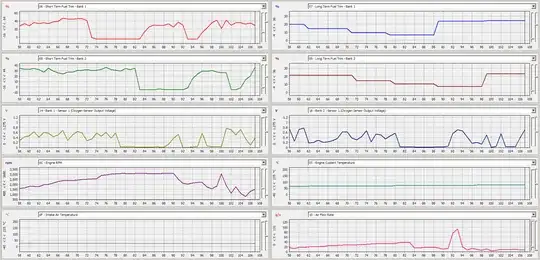Vehicle is a 2006 Ford Courier, started having hesitation/loss of power after fill up at a gas station that I'd never been to before.
I depend on it for transport so I'm forced to still drive it, which does work, but it refuses to go above ~3000 rpm (even with codes reset, and it doesn't sound like it's hitting a rev limiter or limp mode)
I've replaced the fuel pump and fuel filter, no effect. I did obviously miswire the fuel sender, because the gauge no longer works, but does the PCM use that for anything or is it for display only?
Recurring codes: P0171, P0174
Data log of idle with rev up to 3000:

The data in the graphs is offset a bit because of the slow update rate of my scan tool, but the drop to 0v on both O2 sensors surprises me, any ideas on this?
I've also tried spraying carb cleaner all over the intake/air lines in case of vacuum leak but no surging or noticeable difference that I could hear.
My suspicions at this point are:
- Fuel issue after the pump
- Blocked catalytic converter (exhaust has a strange sound to it sometimes)
Very lost at this point, but I'm trying to stay scientific instead of throwing parts at it. I don't have enough experience to be able to interpret the data from the graphs, but they are clearly indicating an extremely lean condition.
Edit: Data from 30s Idle, 30s 3k RPM, 30s Idle
Edit 2: Log while driving ~50km/h

